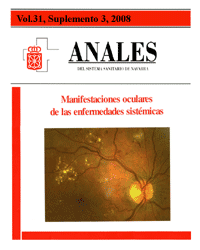Ophthalmological manifestations of cerebrovascular disease
Keywords:
Amaurosis fugaz. Ataque isquémico transitorio. Neuropatía óptica. Parálisis oculomotora. Hemianopsia.Abstract
Transient or persistent loss of vision in one eye is a common and distinctive manifestation of occlusive vascular disease. Occasionally, both eyes are involved together or sequentially, with temporary or even permanent blindness. The internal carotid arteries supply blood to the organ of vision; therefore pathologies of those arteries caused by arteriosclerosis may have a direct influence on its functioning. The most common syndromes are temporary (amaurosis fugax) or constant reduction of visual acuity. In fundus examination central retinal artery occlusion and branch retinal artery occlusion are the most common diagnosis, while retinal vein occlusion, anterior ischemic optic neuropathy, ocular ischemic syndrome are less common. There are many clinical ophtlamological manifestations due to vascular brain damage. Proper recognition and diagnosis of the disease may protect the patient against serious life-threatening complications such as stroke.Downloads
Downloads
Published
How to Cite
Issue
Section
License
La revista Anales del Sistema Sanitario de Navarra es publicada por el Departamento de Salud del Gobierno de Navarra (España), quien conserva los derechos patrimoniales (copyright ) sobre el artículo publicado y favorece y permite la difusión del mismo bajo licencia Creative Commons Reconocimiento-CompartirIgual 4.0 Internacional (CC BY-SA 4.0). Esta licencia permite copiar, usar, difundir, transmitir y exponer públicamente el artículo, siempre que siempre que se cite la autoría y la publicación inicial en Anales del Sistema Sanitario de Navarra, y se distinga la existencia de esta licencia de uso.








